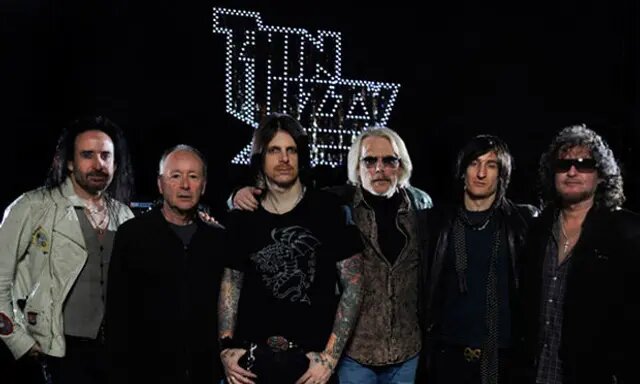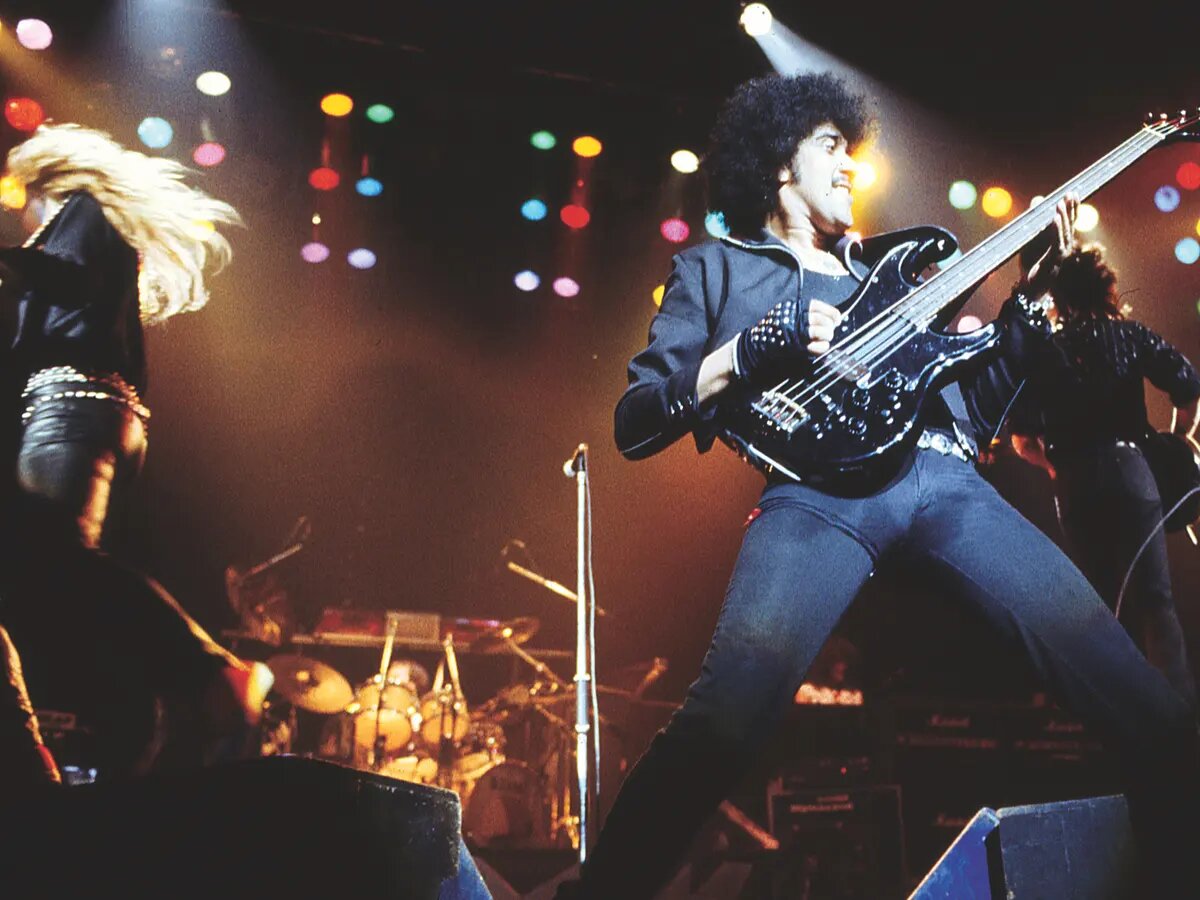
The rise and fall of Thin Lizzy: ‘No one was going to be sitting in the shadows with this band’
The rise and fall of Thin Lizzy: ‘No one was going to be sitting in the shadows with this band’
They were the quintessential rock band, captured in their prime on a new box set. Former members recall the magic and druggy descent of Thin Lizzy – even if they can’t agree on it
If you want to see the platonic ideal of a rock band, go to YouTube and search “Thin Lizzy Rainbow 1978”. You’ll find the band’s classic lineup – Phil Lynott, Brian Downey, Scott Gorham and Brian Robertson – in full flight, and even the degradation of old dubbed recordings can’t diminish their power. Gorham and Robertson flank Lynott, the trio in motion, the two guitarists criss-crossing and taking to the monitors, Lynott in the centre, bass held high, a beautiful, heavy-lidded man half seducing his audience and half assaulting it.
For a couple of years, by this point, Lizzy had been one of the most exciting rock bands around. Their studio albums had finally started matching their live reputation, and the double album Live and Dangerous – a de facto greatest hits for a band who had been a little short on actual hits – had taken their thrilling show to the people who had never seen it.
It wasn’t so easy when the quartet first performed together, at the Wolverhampton Lafayette Club, in July 1974. “Until that first show, no one had even talked about what we were actually going to look like on stage,” Gorham says. “So we get to the Lafayette Club, at which there were about eight paying customers, and Brian Downey on drums counts us in. And Phil and Brian Robertson, they’re flying. Back and forth and around the stage. Wait a minute! Nobody told me we were supposed to do that shit – what the fuck’s going on? And I just cowered back to my amps. Finally, in the middle of a song, Phil walked over, grabbed me by the collar, dragged me to the front of the stage, and said: ‘Don’t fucking move from there.’ He wanted a frontal attack. No one was going to be sitting back in the shadows in this band.”
Lizzy had already released three albums by the time Gorham and Robertson joined, with one UK hit single – a version of the Irish folk standard Whisky in the Jar that reached No 6 in 1972. Their roots stretched back to Downey and Lynott’s time at the Christian Brothers school in Crumlin, Dublin, in the 1960s. “He was the only black guy in the whole school,” Downey says. “So he kind of stood out. You knew who he was.”
The pair were in bands, then in bands together, one of them finally becoming Thin Lizzy. Until, that is, their guitarist Eric Bell drunkenly walked offstage in Belfast on the last night of 1973, in the middle of the set, never to return to the band – although the Bell years are represented on a new six-CD/one-DVD box set, Rock Legends, containing all the Lizzy UK singles, dozens of demos and a disc drawn from a couple of 1980 live shows.
Gorham says Lynott decided he would never again be let down by a guitar player – which proved to be a vain hope – and decided to get two in, so there was always a spare. Robertson, though, has a different version of events. “Scott – we didn’t really want him in the band. But there were reasons for having him. He was American and he had long hair. It was nothing to do with the guitar playing. But Phil was thinking about world domination, about getting to America.”

“At this point, Brian was way more accomplished than I was,” Gorham accepts. “I had only been playing guitar for three years.” But together – after one failure of an album, Nightlife – they gradually worked out a way to play gorgeous, harmonised guitar lines that managed to seem languid and elegant, even when the band was pressing hard on the accelerator. It was something that developed instinctively, according to Gorham. Oh no it wasn’t, Robertson says. “I wrote them. It was scales. Quite simple. Scott didn’t have a grasp of scales at the time. It was as simple as: you pick a melody, then you pick a harmony.”
They had it perfect by 1976’s Jailbreak album, and its single The Boys Are Back in Town, which finally achieved Lynott’s aim of getting a US hit, albeit by accident. “We were asked: ‘What do you think would make a single?’” Downey recalls. “And no one was really sure. Until one of the record company execs had the idea of The Boys Are Back in Town. I went: ‘The Boys Are Back in Town doesn’t sound like a commercial single to me.’ How wrong could you be?”
And this, the moment of greatest triumph, is where everything started to go catastrophically wrong. With The Boys Are Back in Town in the Billboard chart and Lizzy on the road in the US, they had to fly back home after Lynott contracted hepatitis. The following year they had to cancel a US tour after Robertson broke his hand in a brawl at the Speakeasy in London, the night before they were due to leave. The following year, Gary Moore – who replaced Robertson in 1978, and was an on-off member of the band over many years – flew home partway through another US tour, to be temporarily replaced by Midge Ure.

And then, according to Gorham, 1979 saw heroin swamp the band. “We’d always dabbled, but not in the super class-A stuff. It wasn’t until we got to the Black Rose album and we were in Paris. In the hotel, Phil called me up and says: ‘Come on down to my room, I got something I want to show you.’ I had dabbled with heroin in California before I came, so England was saving me. I didn’t know anyone who had it or was doing it, and I was really clean and felt great about life. I walked into Phil’s room and he pulls out this package. He opens it up and I see the brown powder, and he says: ‘You know what this is?’ And I went: ‘Yeah.’ ‘Have you ever done it before?’ ‘Yeah.’ ‘You want to do some now?’ ‘Yeah.’ And that was the start of the whole thing. That was the worst mistake that band ever made.”
Robertson disputes that version. First, he says, Lynott’s hepatitis in 1976 was caused by using a dirty needle; then, that Moore’s departure in 1978 was down to his disgust at the heroin fug around the band. Robertson says heroin had been present in Thin Lizzy throughout the years as a quartet, and “they were keeping it low key, but the management knew”.
Go back to YouTube and search “Thin Lizzy 1983”. You’ll find a band trying to haul itself through the set, fronted by a man whose voice has thickened and coarsened beyond its years (by then he was in his mid-30s). “The band had had a reputation for being impeccable live,” Downey says. “All that was disappearing in front of my eyes and it was so sad to see. Phil and Scott looked so ill. It’s really unfortunate when you see those clips. Phil shouldn’t have been there.”

Leave a Reply